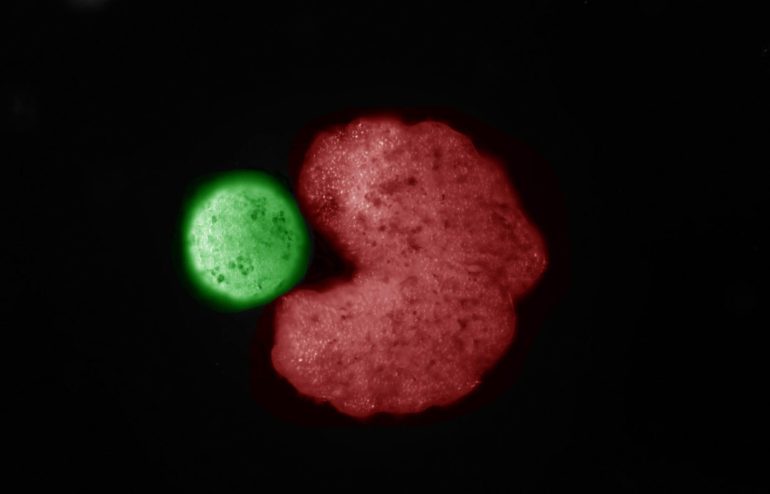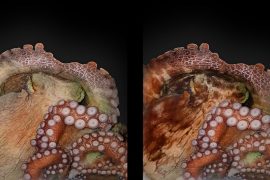They’re called “xenobots” — developers have now discovered another amazing ability in these bio-robots born from frog stem cells: Designer creatures can reproduce by moving free cells together in a suspension. This gives rise to Xenobot babies, which in turn can produce new generations themselves. Experiments show that the effectiveness of the first generation can be increased with a C-shaped design. The researchers emphasize that there is a mode of reproduction known as kinematic self-replication that was previously unknown to living beings.
Man-made little things that can be sent on missions in complex environments: this futuristic-looking concept has taken more and more shape in recent years. Researchers have already built some microscopic robots with drive and specific capabilities. The building materials, however, were mostly metal or plastic and magnetic fields, for example, ensured movement. But in the past two years a new concept has found its way into microrobotics: A US research team presented millimeter-sized robots that are made of living cell tissue rather than artificial components. In this concept, the building material consists of stem cells from the frog Xenopus laevis. Based on this origin, scientists call their designer creatures Xenobots.
cilia make you mobile
Genetic engineering is not required for production – the process is based on the natural growth potential of stem cells: Researchers take this tissue from frog embryos and break it down into smaller units under a microscope. They are then cultivated in a nutrient medium. This is followed by the astonishing development of tiny lumps: they form independently into tiny spheres of about 3000 cells, some of which specialize. This creates shimmer-like eyelashes on the surface of the structures, which move in a directional manner. In frogs, such so-called cilia are usually located on mucous membranes and ensure that foreign bodies are carried away. On the surface of spherical xenobots, on the other hand, they can ensure that the small group of cells continues to move.
In this way, bio-robots can collect information from their environment or “sweep” particles in a suspension. This second effect now forms the basis of the new discovery: When researchers allowed some xenobots with free stem cells to float in a liquid, they found that tiny things were pushing biological building materials together into tiny piles. Key attractions: Within five days, Xenobots, which could move, also formed from these clumps. A start group took care of the development of the offspring.
A “Pac-Man” Appearance Enhances Fertility
Experiments have shown that some of the “children” were later able to take care of another generation again. However, they were no longer as dominant as their “parents” because they are composed of fewer cells: the fertility of the younger subsequent generation is greatly reduced. “The system is difficult to multiply. So it usually dies very quickly,” says lead author Sam Craigman of Tufts University in Medford. So, the researchers next looked to find out whether the parental generation had a certain The ability to reproduce could be improved by shaping the manner in which a computer system based on artificial intelligence was also used. It was concluded that a C-shape would be best for pushing the cells together in clumps. Microscope Under the U.S., scientists created an original generation of Xenobots that look like “Pac-Man” from the famous 1980s video game.
Experiments then confirmed that these versions were indeed capable of sweeping a particularly large amount of cell material together. They then created correspondingly larger baby xenobots with increased ability to reproduce further. With the form-adapted parents, the researchers eventually achieved four generations. In other words, Pac-Man Xenobots had children, grandchildren, great-grandchildren and, ultimately, great-grandchildren. However, they do not pass on their C-shape: the offspring have a rounded shape and therefore eventually become too small to produce a second generation.
hitherto unknown by living beings
As the researchers point out, the phenomenon is a form of reproduction known as kinetic self-replication. So far it is only known at the molecular level, but it has never been observed in organisms. “In our case, we are dealing with frog cells that replicate in a way that is very different from prepared frogs, for example: no animal or plant known to science replicates itself in this way. ” Craigman says.
According to the researchers, in addition to the system’s potential uses in bio-robotics, the observations also provide other interesting clues: “The fact that this unique replication strategy arises spontaneously and does not evolve through specific selection, An example of plasticity in biological systems. Although kinetic self-replication has not yet been observed in today’s cellular life forms, it may have been essential in the origin of life,” the researchers write.
Source: University of Vermont, Article: PNAS, DOI: 10.1073/pns.2112672118

Web guru. Amateur thinker. Unapologetic problem solver. Zombie expert. Hipster-friendly travel geek. Social mediaholic.





